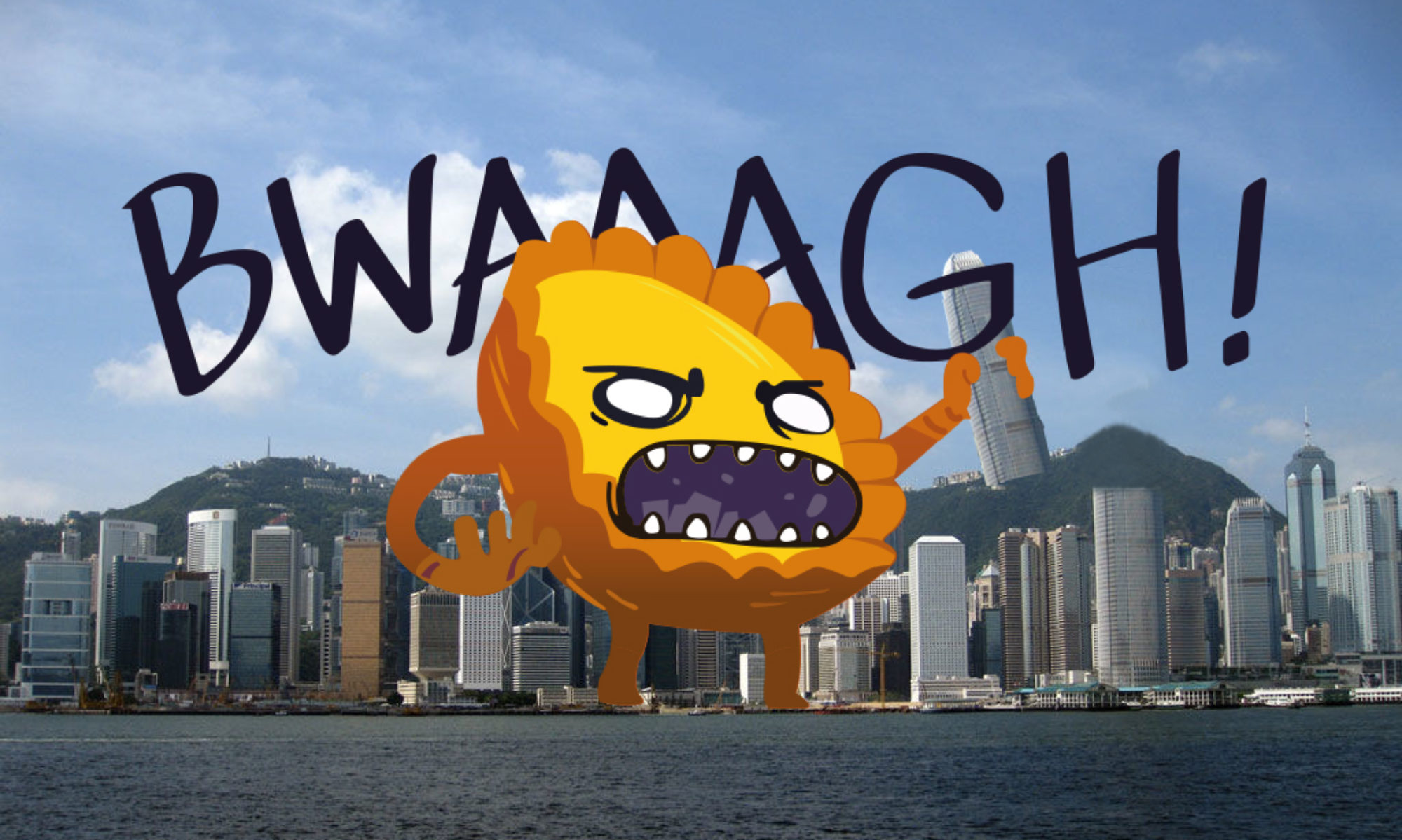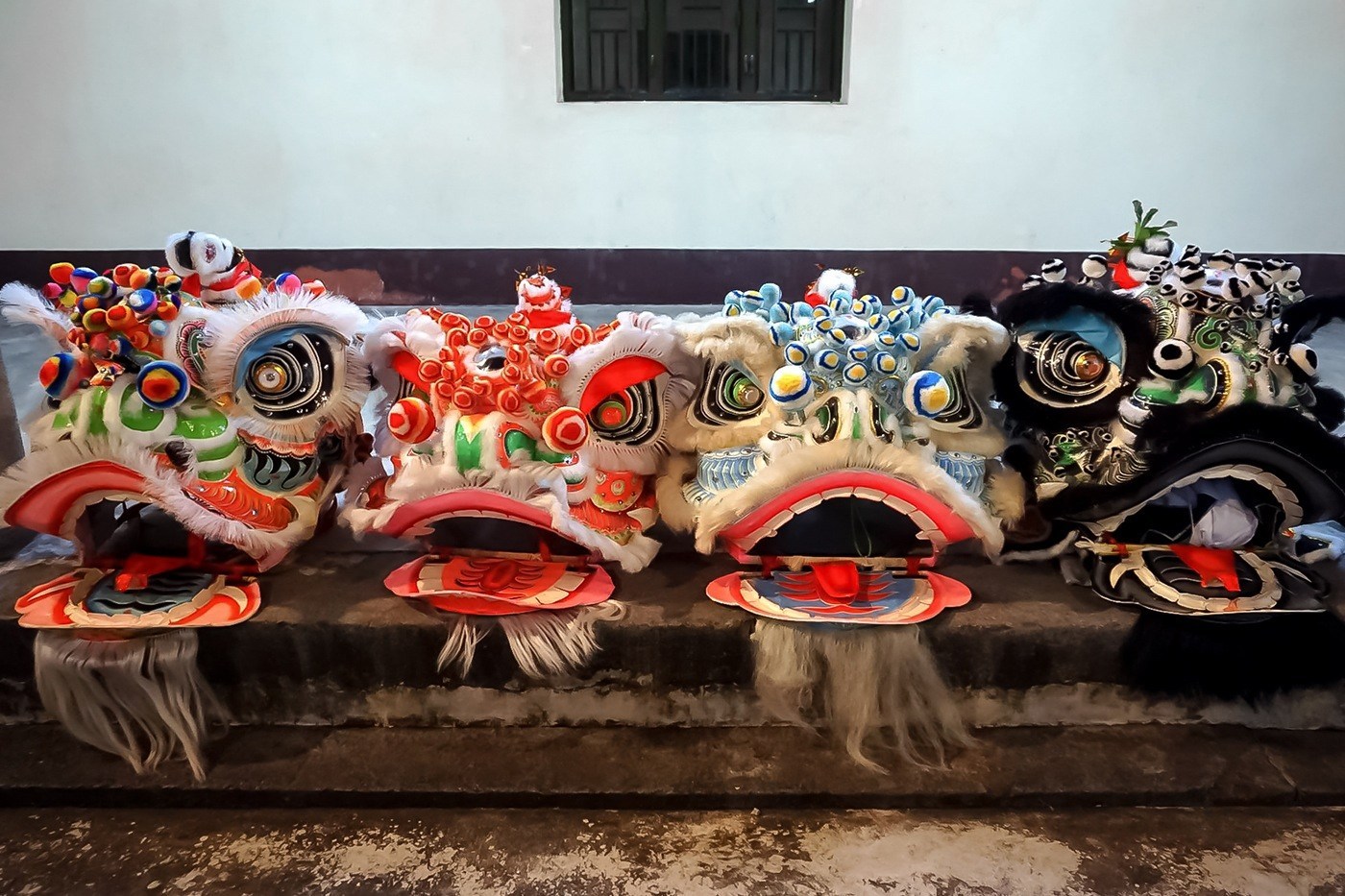Written by Billy Potts
This is the eighth in a series of articles in which we explore the imaginary creatures of Hong Kong, their makers and those that take part in their culture. The eighth cryptid in our fantastic menagerie, the lion, is the most commonly seen around the territory. This article was first published in Zolima City Mag
The heavy scent of lilies rolls down Cooke Street like a black ribbon. It is late afternoon in Hung Hom. The air is still and walking through hearse-lined streets causes the head to pound from drubbing heat. This is death’s precinct.
The shop at number 6 is swathed in burgundy tarpaulin. Pushing past clear plastic sheeting we find Master Yu Ying-ho with a customer who has very specific requirements. “VR goggles, a PS4 and some white t-shirts,” says the customer. This is Ho Kee, one of innumerable shops selling paper offerings in the shadow of Hung Hom’s monolithic funeral homes.

Clad in shorts, Adidas slides and a vest emblazoned with the shop’s name, the 36-year-old lion maker is unashamedly brusque. “Don’t take offence! That’s just the way I am!” he exclaims. Yu has been in the paper offerings business for over 10 years, but has been making lions for almost 20. Born the son of a bonesetter, lion dancing has always been a part of his life. As a youngster, Yu observed lion makers from a distance and tried to reproduce what he saw. None of the makers would divulge their secrets, citing the boy’s tender age as an excuse. Having spent years as a dilettante, Yu was finally offered an apprenticeship by an old sifu (master), Wong Kai. The teenager took up residence in the master’s Sai Ying Pun shop and learned the craft. Entering his 20s, the young lion maker had his art but realised he would need a trade. He was taken on as an apprentice at a funerary goods shop and began making a living with products for the dead.
Southern Chinese lions (naam4 si1 南獅) originated in Guangdong and are divided between Fut San and Hok San traditions. Fut San lion dancing places heavy emphasis on martial arts while the Hok San style is more playful. Across China lions come in all shapes, including shaggy northern lions (bak1 si1 北獅), and the golden lions (gam1 si1 金獅) of Shanmei, which, according to Peng Chau lion maker Ringo Leung, are similar in construction to suilins (seoi6 leon4 瑞麟), but lack the distinctive golden horn.
Before Guangdong, the lions trace their origin to northern China – and Persia before that. They were presented as gifts to the emperor sometime in the late Han Dynasty (206 BC-220 AD). These regal felines stirred the imagination and quickly took their place in folk tradition that began what we now know as lion dancing.
Yu tells a less prosaic tale. “All the lions of China can be traced to a common ancestor – a monster called the Nian, which terrorised villages and destroyed crops. Villagers created the monster’s likeness, parading it with drums, cymbals and firecrackers to scare Nian away. After banishing the brute, the likenesses became part of tradition, ringing in the Lunar New Year, celebrating weddings, honouring special guests and opening new businesses. From that time on they have always been referred to as lions.
Having subdued one monster, the leonine beasts fell victim to another: the Cultural Revolution and the destruction of what Mao Zedong called the “Four Olds”: old customs, culture, habits and ideas. The pride was decimated. Many craftsmen escaped to Hong Kong where the art flourished thanks to an abundance of fine materials in the cosmopolitan port.






The art of lion dancing itself is remarkably competitive. The first World Lion Dance Championship was held in 1994 and today this tournament is a global attraction. Teams from all over the world vie for supremacy with high energy movements and well honed artistry. Lion dancing is closely related to martial arts, but it has evolved to incorporate elements of acrobatics, as well as gestures that accentuate the lions’ expressions. Dances are sometimes performed on small circular platforms raised atop poles that can be up to six metres in height. Dancers leap light-footedly from pole to pole in feats of tandem acrobatics, all while manipulating the lion with its blinking eyes and hinged mouth.
In the past, competition was both literally and figuratively cutthroat. Lion dancing has historical links to triad societies as well as martial arts associations. In the 1950s and 60s, rival troupes would conceal knives within the silken folds of their costumes, turning festivities into a blood-soaked danse macabre. As a result, lion dancing was outlawed and though the prohibition was brief, a police permit is still required for any lion dance occurring within the city.
Yu claims not to view lion making as a business. “I need to be in a good mood. No phone, no computer, no other people,” he says. “I don’t like people hovering around filming me and getting in the way.” Yu’s lion making saps energy and encroaches on family life. “This is for my own interest. There is no way I could charge enough for what I put in so I don’t calculate with money.” When the day’s toil is over, Master Yu shutters his shop and works by night. In the nocturne he gives life to vibrant snarling beasts amidst the paraphernalia of death.
“I could teach you how to do this in 10 minutes,” Yu explains casually, “but it’ll take years to master those few skills.” Says Yu, lion making requires skill at cane frame building, calligraphy and colour theory. “The most difficult part is the cane work,” he expounds while dragging out lengths of the fibrous material. Laying one piece across his lap, he planes it down with what looks like a vegetable cleaver. The cane is whittled down until it forms a supple switch. Frames are constructed by applying heat and bending the malleable rods into intricate structures held together with strips of paper, slathered in paste and wound around the cane. According to Anita Jack of the Golden Dragon Museum, once dry, the best lion frames are able to support the weight of a person standing on top of them.
“The most important part of making a lion is the painting,” says Yu with a smile. “It’s the colours that grab your attention. It’s like makeup. Some people have beautiful facial features but they don’t know how to apply makeup so they don’t look their best.” It takes real mastery to paint a lion, the master explains. “You need the mind and skill of an artist because a lion’s head isn’t flat, it’s three dimensional. If the lion looks like it is in motion, then it is beautiful.”

Yu stops to muse wistfully about his craft. “There’s no explaining why you do certain things. It’s completely abstract. I am not strong so I can’t do construction, yet I am not smart, so all I can do is make lions. Inspiration takes me when I start. Art cannot be predetermined. Some people create the same lion again and again but mine are all different.”
Patrons seeking to commission Yu can expect a long wait – if the master is willing to entertain. They will also pay handsomely for the privilege: one of Yu’s lions costs HK$20,000 on average but prices climb as the lion becomes more traditional and more embellished. Yu makes fewer than 20 lions a year; in 2016 he decided to make none at all.
Over time, market forces have tamed Hong Kong’s lions, making them cute and amiable. These lions, with their fluffy white brows and friendly eyes, are a reflection of commercial tastes. If, however, you should come across a Yu Ying Ho lion, pay attention to the painted mien. Vivid lines, applied with the flowing precision of calligraphy, give the illusion of movement. Cuddly and cute these lions are not. Their gleaming obsidian brows, hand-made from fine fishing line bound with taut ligature, are razor sharp, giving a ferocious intensity to those feline eyes which stare the viewer down like prey. There is fierce intelligence in those eyes; these lions are no brutes. They seem to commune with the beholder.

